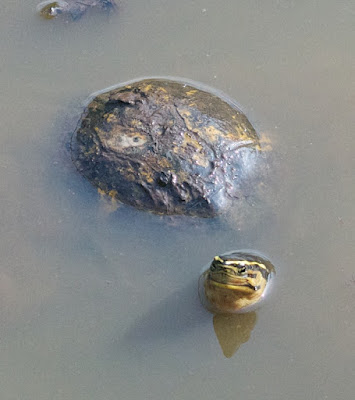Wednesday, December 21, 2016
Sarawak: Monkeys, Chicks and Turtles
Sama Jaya is very much an urban park, surrounded by the houses and markets of Stutong (a district of Kuching) and busy with locals hiking the trails for exercise. As readers of this blog will know, however, it is rich in local wildlife - at least of the smaller variety. Though it protects a patch of lowland peat forest, it is simply too small and too isolated to support populations of most true forest birds and mammals. The local troop of Long-tailed Macaques (Macaca fascicularis) is not an exception. These are practically urban animals, thriving in the heart of many of Southeast Asia's larger cities.
As urban survivors, I suspect that young macaques in Sama Jaya will continue to exasperate their parents for many years to come.
Some of the survivors at Sama Jaya are more surprising. Hans Breuer tells me that there is a population of Western Tarsiers (Tarsius bancanus) here, though as I have never been in the park by night I have yet to see these strictly nocturnal creatures. On the other hand, the pair of Crested Fireback Pheasants (Lophura ignita) that used to be a regular sight treading unconcernedly along the trails have long disappeared, and the closest you can get to them today (or at least on September 22 and 23, 2014, when I took these photos) are Domestic Chickens (Gallus gallus).
You can still see a range of forest plants here, including rattan palms...
… whose thorns you would do well not to encounter ...
...as well as a variety of forest flowers.
The park is a good place to photograph insects, including dragonflies (this is Orthetrum chrysis)...
…or just plain flies, including this Robber Fly [Asilidae].
The endemic Striped Tree Skink (Apterygodon vittatus), a skink that is, unusually, easy to identify, is common in the forest.
The pond in the centre of the park has a few turtles (as well as being an excellent dragonfly spot), though I suspect they were released here. Certainly this Red-eared Slider (Chrysemys picta elegans), a naive of the southeastern United States, could not have reached Sarawak (or, probably, this pond in particular) without human help.
This South Asian Box Turtle (Cuora amboinensis) may also have been brought to the pond by people, but it is a native.
Southeast Asian turtles have been particularly hard hit by the wildlife trade, and many species of Cuora have become extremely rare. This species, the most widespread in the genus, seems to be holding its own, though certainly in diminished numbers.
Turtles are extremely interesting animals (those curious to know why are encouraged, modesty aside, to buy my book Turtles, Tortoises and Terrapins: A Natural History), and one of the most interesting things about them is the variety of ways they breathe. Some aquatic turtles (and Cuora box turtles are far more aquatic than North American box turtles (Terrapene), to which they are only distantly related) may spend long periods of time fully submerged. Some can extract oxygen from water through the linings of their throats or, in a few Australian cases, their anuses.
What, however, is this turtle doing? Well, technically, it's called buccal oscillation. A submerged turtle may do this to draw water into its throat through its nostrils, and that does have something to do with extracting oxygen. Above water, though, it seems to be more akin to human sniffing - a way to test for scents in the air, perhaps in particular those from annoying human nature photographers.
At the edge of the pond, the turtles leave tracks in the mud as a sign of their presence - and as an indication that, in Sarawak, even a pond in a city park is worth investigating.
Subscribe to:
Post Comments (Atom)









![Robber Fly [Asilidae] Robber Fly [Asilidae]](https://blogger.googleusercontent.com/img/b/R29vZ2xl/AVvXsEi_eLZ728BaY0ZYZNRhXvFg1ArjKYSZeOsZ2StNpIf5OMYNXW38iP8fqV2i6ATow1qDGyN0fWbiwWcl3i8IpgaiqLpNafJusjEzO1cS-Aa0UpBgJLTjkfx9H9IRCs-Us7Z2sK4_2_D2gm4/s400/Robber+Fly+%255BAsilidae%255D+DSC_0104.jpg)












No comments:
Post a Comment